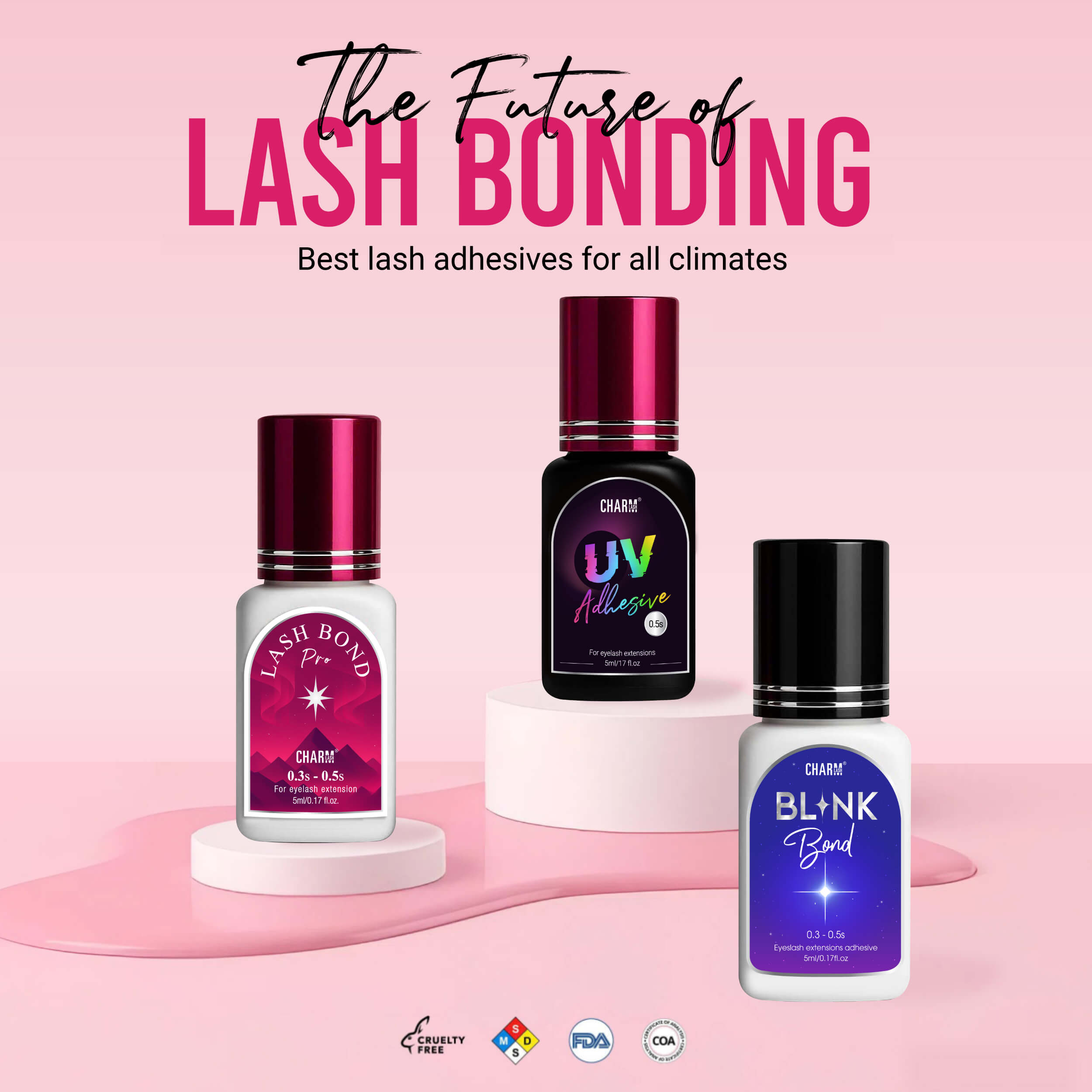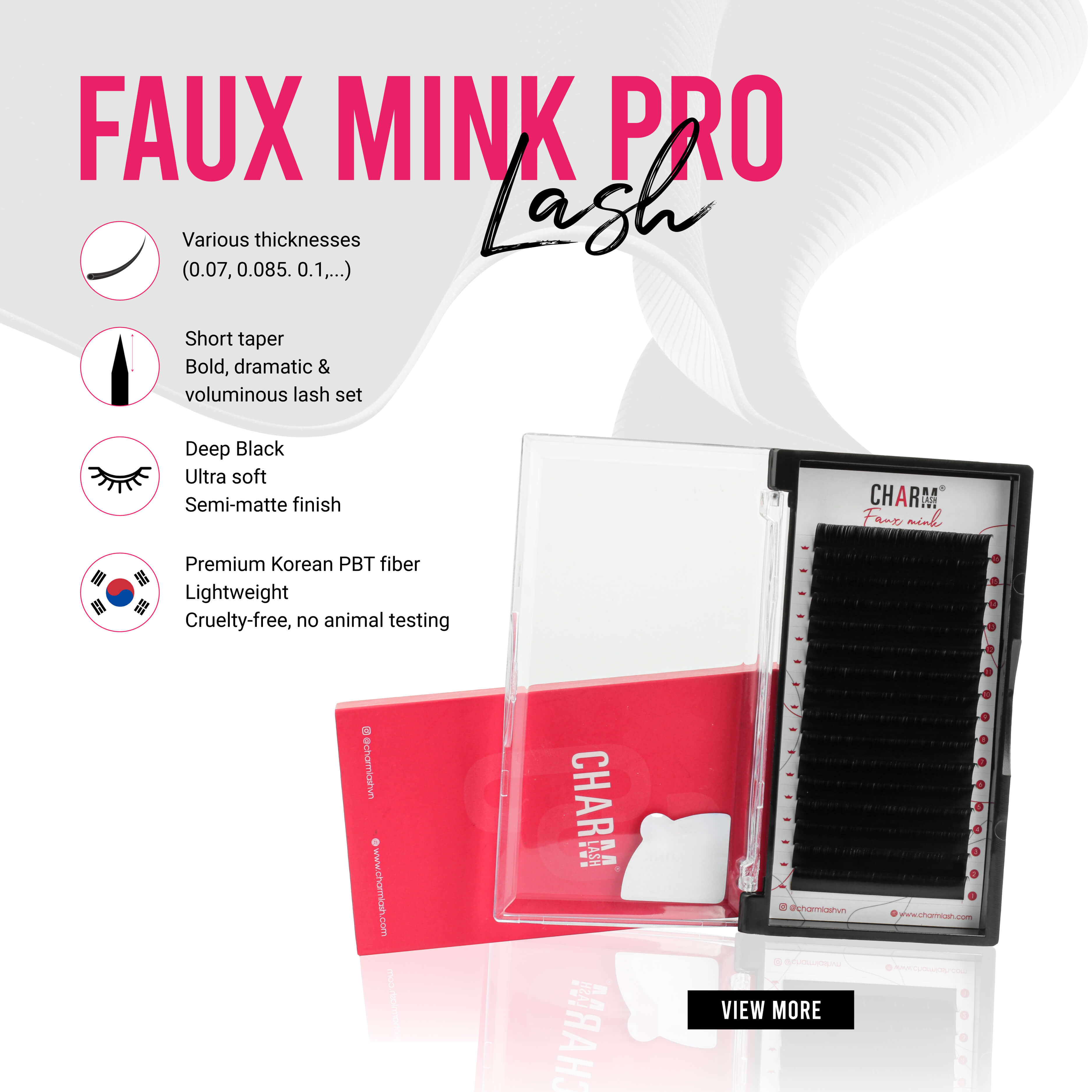Are you a lash enthusiast, or considering eyelash extensions to enhance your beauty? While lash extensions can be a game-changer, some individuals experience allergic reactions to the glue used in the process. In this comprehensive guide, we’ll delve into the essential details about allergy to lash glue, helping you understand the reactions, causes, symptoms, treatments, and preventive measures.

Understanding allergy to lash glue reactions
An allergic reaction is the way our body responds to a substance it sees as a harmful invader, known as an allergen. Allergens can be things like pollen, peanuts, or ingredients in products like eyelash glue. Unfortunately, we don’t always know why certain people’s bodies react to specific allergens.
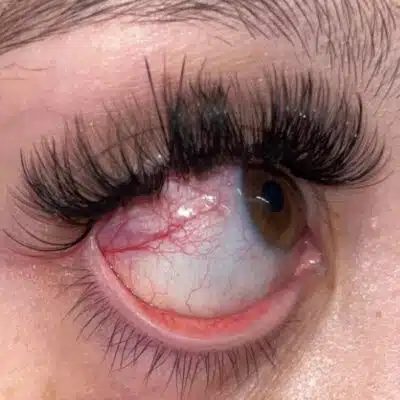
When our body encounters an allergen, it produces fighters called antibodies to combat it. The more exposure to an allergen, the stronger the body’s reaction can become. This increased exposure can lead to more severe allergic reactions over time.
In the case of eyelash, allergy to lash glue are caused by specific ingredients, such as cyanoacrylate or proteins found in latex or formaldehyde. Especially, if you’ve had allergic reactions to similar things before, like latex gloves or Band-Aids. Symptoms of an allergic reaction to eyelash extensions include redness, itching, irritation, burning, stinging, watery eyes, runny nose, swelling, and headaches.
It’s crucial to distinguish between an allergic reaction, which is severe and long-lasting, and irritation, which is temporary discomfort that usually goes away quickly. Not everyone is allergic to everything, and lash extension allergies can vary in symptoms and reactions from person to person.
You may want to know more about The reasons why you suddenly get lash extension allergy and how to combat it
Compare allergy to lash glue and irritations
Distinguishing between lash allergies and irritations is crucial for lash artists dealing with clients’ reactions. Here is the table to help you out.
| Aspect | Lash Allergy | Lash Irritation |
| Onset | Shows up immediately but may also appear after 24 to 48 hours | Symptoms typically appear immediately, often within minutes. |
| Eye Involvement | May affect one or both eyes | Often occurs in one eye |
| Severity | One eye may experience a severe reaction | Reactions may vary between different eyes. |
| Duration | can range from a few hours to a few days | Disappears within a day |
| Progression | If left untreated, the condition tends to worsen over time | Symptoms tend to improve with the passage of time |
Causes of Glue Allergic Reactions
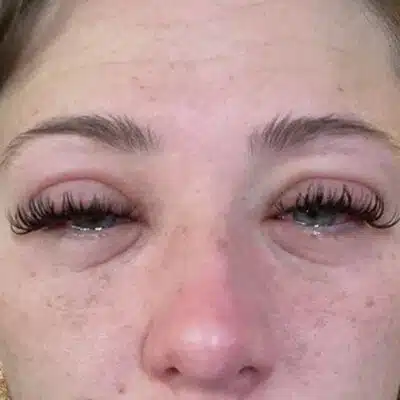
Allergic reactions to lash extensions are primarily caused by the lash glue, with Cyanoacrylate, a key component, being the usual culprit. This substance, responsible for the glue’s curing process, tends to attach itself to humidity, making the eyes and nostrils, the most humid parts of our face, susceptible to symptoms like watery eyes and a runny nose.
Unfortunately, if someone is allergic to Cyanoacrylate, they remain allergic, much like being allergic to common allergens such as pollen or dust. Removing extensions during regular allergy seasons, like spring or fall, is recommended if clients are only sensitive during these times.
Stress can also contribute to allergy to lash glue, as increased stress may push more hairs into the resting phase of the hair growth cycle, leading to hair loss along with the extensions. Another trigger for lash extension allergies is often the Formaldehyde fumes released during the adhesive curing process. Other potential causes include carbon black in the glue, certain tapes used during the process, and natural lash fibers, especially from mink, making synthetic lashes a preferable and hypoallergenic option for most individuals.
Decoding Allergic Reactions: Unveiling Symptoms of Lash Extension Glue Sensitivity
Symptoms of an allergy to lash glue can differ from person to person, but commonly observed signs include:
- Irritation with stinging and watery eyes (Red eyes after lash extensions)
- Sore throat
- Nasal symptoms like a runny or blocked nose
- Headaches
- Swelling and itching of the eyelids
While only a small number of clients may develop an allergy to lash glue, it’s generally not dangerous, and symptoms vanish upon removing the extensions. However, the allergic reactions might recur if extensions are reapplied, as the body remembers it. This applies not only to clients but also to lash artists who can develop a glue allergy from prolonged exposure to strong fumes over time.
Awareness and precautions are essential in the lash extension industry for the well-being of both clients and artists.
Duration of Allergic Reactions
When it comes to allergic reactions from eyelash extensions, it’s key to act swiftly. Unlike quick-fading lash irritations, allergies can stick around for a few hours to a few days, depending on the allergen and how soon it’s removed.
Here’s the catch – once you develop an allergy, it tends to stay with you for life. If you find yourself in the midst of a lash reaction, don’t hesitate to talk to your lash tech and see an eye doctor for guidance on the best steps to take.
The good news is that with the right treatment, lash allergies can vanish relatively quickly. Understanding how long these reactions last emphasizes the need for proactive measures to ensure a comfy and safe lash extension experience.
Treatment Options
1. Immediate Lash Extension Removal:
- Prompt Action: Remove lash extensions immediately to eliminate exposure to the allergen.
- Complimentary Removal: Offer clients a complimentary removal service to address the allergic reaction promptly. In such case, you could use our Cream Remover.
2. Shortened Fill Times:
Reduce Exposure: Instead of waiting two to three weeks for lash fills, consider shorter intervals, minimizing the chance of sensitivity and reaction.
3. Use of Fans During Appointments:
Disperse Chemicals: Employing a fan during lash extension appointments can help disperse chemicals in the adhesive, reducing the likelihood of sensitivity. Always prioritize the comfort and safety of clients experiencing an allergy to lash glue. Taking swift and preventive measures can contribute to a more pleasant lash extension experience.
Preventing Allergic Reactions
1. Anti-Allergy Gel:
- Ensure an open jar of anti-allergy gel during lash appointments to absorb fumes from lash glue, protecting eyes and nostrils.
- Request a lash glue without carbon black if sensitive to black dye.
- Communicate concerns to the lash tech for alternative adhesives with reduced amount of cyanoacrylates.
- Consider a patch test, often offered by some studios, or request one if not routinely conducted.
- Take the initiative to check product ingredients if extra cautious.
2. Sensitive Lash Extension Glues:
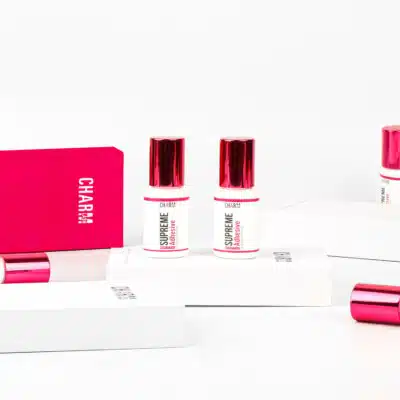
- Opt for sensitive lash extension glues with lower amounts of cyanoacrylate.
- Prioritize the well-being of clients with sensitive eyes or immune systems over fastest drying or longest retention glues
Taking these steps can significantly contribute to a comfortable and irritation-free lash extension experience. Read more about: Eyelash Extension Adhesive Allergy: 7 Best Tips to Prevent
In Conclusion
While eyelash extensions can enhance your beauty, it’s crucial to be aware of potential allergic reactions to the glue used in the process. Understanding the causes, symptoms, and treatment options is vital for both clients and lash artists.
Allergy to lash glue are not particularly dangerous, but they can reoccur if extensions are reapplied, emphasizing the importance of preventative measures. From using anti-allergy gel to opting for sensitive lash extension glues, these steps contribute to a more pleasant and allergic-free lash extension experience.
 Afrikaans
Afrikaans Albanian
Albanian Amharic
Amharic Arabic
Arabic Armenian
Armenian Azerbaijani
Azerbaijani Basque
Basque Belarusian
Belarusian Bengali
Bengali Bosnian
Bosnian Bulgarian
Bulgarian Catalan
Catalan Cebuano
Cebuano Chichewa
Chichewa Chinese (Simplified)
Chinese (Simplified) Chinese (Traditional)
Chinese (Traditional) Corsican
Corsican Croatian
Croatian Czech
Czech Danish
Danish Dutch
Dutch English
English Esperanto
Esperanto Estonian
Estonian Filipino
Filipino Finnish
Finnish French
French Frisian
Frisian Galician
Galician Georgian
Georgian German
German Greek
Greek Gujarati
Gujarati Haitian Creole
Haitian Creole Hausa
Hausa Hawaiian
Hawaiian Hebrew
Hebrew Hindi
Hindi Hmong
Hmong Hungarian
Hungarian Icelandic
Icelandic Igbo
Igbo Indonesian
Indonesian Irish
Irish Italian
Italian Japanese
Japanese Javanese
Javanese Kannada
Kannada Kazakh
Kazakh Khmer
Khmer Korean
Korean Kurdish (Kurmanji)
Kurdish (Kurmanji) Kyrgyz
Kyrgyz Lao
Lao Latin
Latin Latvian
Latvian Lithuanian
Lithuanian Luxembourgish
Luxembourgish Macedonian
Macedonian Malagasy
Malagasy Malay
Malay Malayalam
Malayalam Maltese
Maltese Maori
Maori Marathi
Marathi Mongolian
Mongolian Myanmar (Burmese)
Myanmar (Burmese) Nepali
Nepali Norwegian
Norwegian Pashto
Pashto Persian
Persian Polish
Polish Portuguese
Portuguese Punjabi
Punjabi Romanian
Romanian Russian
Russian Samoan
Samoan Scottish Gaelic
Scottish Gaelic Serbian
Serbian Sesotho
Sesotho Shona
Shona Sindhi
Sindhi Sinhala
Sinhala Slovak
Slovak Slovenian
Slovenian Somali
Somali Spanish
Spanish Sundanese
Sundanese Swahili
Swahili Swedish
Swedish Tajik
Tajik Tamil
Tamil Telugu
Telugu Thai
Thai Turkish
Turkish Ukrainian
Ukrainian Urdu
Urdu Uzbek
Uzbek Vietnamese
Vietnamese Welsh
Welsh Xhosa
Xhosa Yiddish
Yiddish Yoruba
Yoruba Zulu
Zulu














